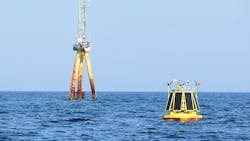CLS advancing development of floating LIDAR offshore wind measurement technology
Offshore staff
RAMONVILLE SAINT-AGNE, France – CLS has secured certification of its DeepCLiDAR Floating LiDAR (FLiDAR) technology.
The company aims to combine the technology with its in-situ metocean data collection, satellite radar observations, data derivation, and high-resolution wind field modeling into its SARWind service for the offshore wind sector.
It has established a production facility in Cape Town, South Africa.
The CLS DeepCLiDAR, FLiDAR buoy’s hull is said to be similar to the NOAA 3 Meter Discus buoy design.
The buoy is said to follow wave motions, enabling accurate wave measurements alongside other metocean and marine environmental readings.
DeepCLiDAR can be deployed in coastal, shelf, and deep waters, providing configurable wind profile measurements at various points from 19 to 300 m above sea level.
Various configurations are possible, depending on wave conditions and local weather, with the modular and adaptable design supporting a range of metocean and environmental sensors.
The buoy structure incorporates bi-directional CERTUS Iridium and cellular communication for data transmission and system management, and is powered by renewable energy via its solar panels.
According to CLS, DeepCLiDAR can measure and monitor wind profiles over extended periods without the need for intervention.
The first model was constructed at Woods Hole Group facility in Bourne, Massachusetts, and deployed at the Woods Hole Oceanographic Institute (WHOI) ASIT FLiDAR test site for over seven months. It was able to withstand the impact of Hurricane Franklin last year, and provided best-practice data, according to DNV independent analysis.
02.27.2024
